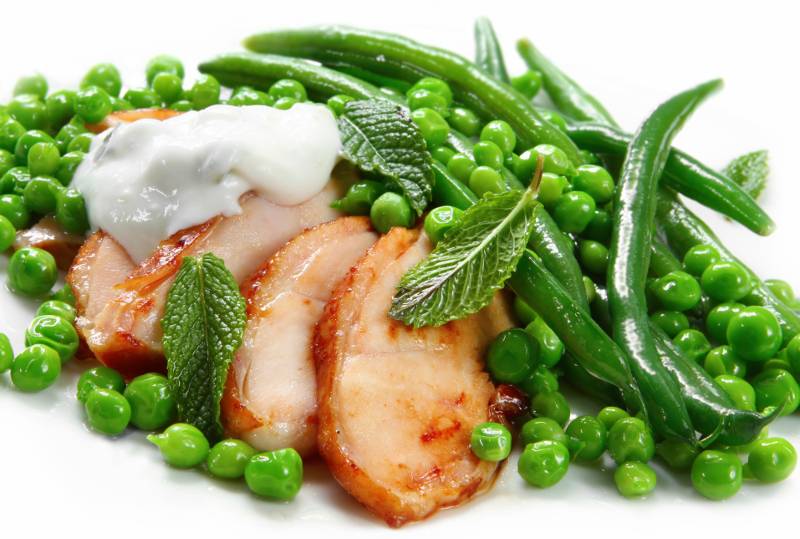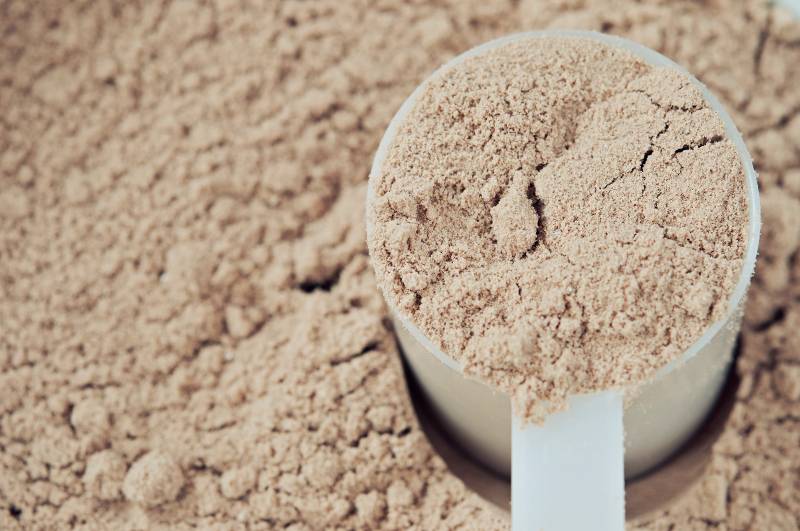
Protein guide
What is protein and why is it important?
The word ‘protein’ comes from Greek and it means ‘of primary importance’. And rightly so: energy for your body is provided by three macronutrients, protein, fat and carbohydrate.
Protein is a linked chain of amino acids. Amino acids are your body’s primary source of nitrogen. Your body needs a positive nitrogen balance for muscle growth and recovery; however, proteins also have several other functions besides their muscle building properties.
- maintain the pH balance of blood
- protect muscle tissues during a diet
- provide a source of energy when no carbohydrates are available
- contribute to hormone production and maintaining hormone levels
- necessary for certain chemical reactions
- contribute to the normal functioning of the immune system
- contribute to maintaining the fluid balance of the body
Proteins and muscle growth
Increasing your daily protein intake while doing weight training can effectively support the growth of your muscle mass. The circulation of proteins in the human body is constant; muscle tissues are continuously regenerated and replaced. In order to maximise this process, you need to ensure a continuous positive nitrogen balance, which you can achieve by additional protein intake.
If your protein intake is insufficient, your muscles will be unable to recover and your body will break them down. But insufficient protein intake can also have a negative effect on a number of bodily functions which require protein (e.g. hormone control, pH of blood, etc.).
When doing weight training, more than the normal amount of muscle tissue needs to be recovered, and therefore weightlifters, power lifters and bodybuilders need an increased protein intake to ensure the necessary amount continuously.
Proteins and weight loss
Since their digestion needs more energy, protein-rich foods have a thermogenic effect. In order to process proteins, your body needs to work 30% harder than in the case of carbohydrates or fats. Consequently, the consumption of protein-rich foods increases metabolism.
You also need the right amount and quality of proteins to mobilise your fat reserves. If your protein intake is insufficient, your body will choose to break down the muscle tissues to gain energy.
Proteins and recovery
Protein has a fundamental role in the recovery of muscle tissues. During your workout, two things happen:
- the glycogen stores of the muscles become depleted
- micro-tears appear in the muscle fibres which need to be restored
If protein supply is continuous, your body has a positive nitrogen balance and muscle recovery begins immediately after workout. The faster this process, the more quickly muscle tissues are built and you can begin your next training session.

Nutritional supplements as a source of protein
Nutritional supplements can contain various protein sources. What’s the difference between them?
Whey protein:
Whey accounts for about 20% of the protein content of milk. A by-product of cheese production, whey is today the most popular source of protein among athletes. Due to its high biological value, your body utilizes whey very efficiently, which also has a high BCAA content. By default (with no added amounts), it has a low Glutamine and Arginine content.
- Whey concentrate:
a more cost-effective version of whey protein. It has a more simple production technology, takes less time to produce than whey isolate and it contains a little more fat and lactose. Considering its price-to-value ratio, it’s a particularly good choice for athletes doing weight training.
- Whey isolate:
It’s a more expensive version of whey. It has a higher content of quality protein and a higher biological value. It contains less fat and lactose than whey concentrate. Its unflavoured version can contain over 90% of protein, whereas whey concentrate has only about 80%. It’s the best choice for a diet. Through a pre-digestion process, an even purer protein source can be produced – it’s called whey hydrolysate.
- Whey protein mixture:
A mixture of isolate and concentrate. By combining the advantages of the two protein sources, it offers a high-quality protein source of excellent price-to-value ratio.
Casein:
Casein accounts for 80% of the protein content of milk. It’s a slow absorbing protein, with a nice, rich flavour. That is exactly why it’s commonly used in mass gainers. Although its biological value is lower than that of whey protein, it is more effective in muscle building, as your body uses casein to build muscles, rather than as a source of energy. It also has a high Glutamine content.
Egg white (albumin):
It has a high content of essential and non-essential amino acids and less cholesterol than a whole egg. Many consider eggs the king of protein sources. Biological value is also measured against eggs; therefore, egg white protein was given a value of 100. It’s the best protein source for those sensitive to lactose.
Soy protein:
Although it’s a high-quality protein, it’s not as effective as milk based proteins. It’s easy to digest, with an average amino profile. It has a lower biological value than whey proteins, but it can be a good choice to ensure protein intake when money is short. It’s also a popular choice among those sensitive to milk as well as vegans.
Wheat protein:
It’s a healthy and natural alternative to milk and egg based proteins. It’s free of lactose and cholesterol, which makes it an excellent choice for vegetarian bodybuilders and other athletes. It has a high Glutamine content. It’s a second class protein source, with a low biological value.
Pea protein:
It’s a 100% gluten-free protein source, also a good choice for vegetarians. It’s free of lactose and cholesterol, easy to digest and a rich source of protein. Currently, it’s not very wide-spread, although its production is more environment-friendly than that of whey proteins.
Whole milk protein:
Dried protein extracted from milk, with carbohydrate and fat removed. It’s extremely nourishing, with a high calcium and considerable vitamin and mineral content. Whole milk protein contains both whey and casein.

The advantages of protein shakes
- Bodybuilders and power athletes have 5-8 smaller meals a day. Preparing so much food is a time-consuming task, as opposed to a simple shake, which only takes seconds to mix with water in a shaker. Also, anything can happen to prevent you from heating your food and eating it, whereas you can drink your shake anywhere, in any circumstances. No need for plates, cooling or heating, either.
- Considering their protein content, protein shakes are also cost-effective.
- Due to their fast absorption and digestibility, they are especially effective after workout.
When should I drink protein shakes?
When it comes to proteins, timing is very important for the best results. It’s important that you should find the best tasting and most effective protein source, but you should also pay attention to timing, so you can fully enjoy the benefits of protein shakes:
- First meal in the morning: A long time has passed since your last meal, so your body is ‘starving’ and it needs amino supply. The best choice is a protein shake which contains both slow and fast absorbing protein sources. Through the fast absorbing proteins, cells quickly get fuel, whereas the slow absorbing protein source ensures the right amino acid levels for a couple of hours.
- Before workout: The meal (60-90 minutes) before workout should also contain some medium absorbing proteins to provide the necessary amount of amino acids during the exercises.
- After workout: It’s the most important time to drink a protein shake. You should go for a fast absorbing protein source so the anabolic processes can begin as soon as possible. The maximum of 30 minutes after workout is the period of the so-called anabolic gate, when your body uses the amino acids required for recovery particularly effectively. One or two hours after workout a meal containing complex, slow absorbing protein sources should be taken.
When else should I take proteins?
- Between meals: if you don’t have a chance to eat some solid food, you should drink one or two slow absorbing protein shakes during the day, too.
- At night: You can also drink some slow absorbing proteins before going to bed, to ensure a positive nitrogen balance for the night, too. If you wake up at night, a casein shake can be a good choice.
Proteins and carbohydrates to gain mass
When in the mass gaining period, combine your proteins with high-quality carbohydrates. For this purpose, pre-mixed mass gainer supplements are great, but you can also prepare them from the necessary ingredients if you want to take exact amounts.
High-quality carbohydrates contribute to the transport and utilisation of proteins. Carbohydrate intake causes blood sugar levels to increase, which your body tries to restore by releasing insulin. Insulin is an anabolic hormone which directs nutrients in the blood to the cells. Thus, Amino acids in the blood stream can get to the muscle cells more easily, too, and in addition, the glycogen stores depleted during hard training are also quickly replenished, which supports recovery.